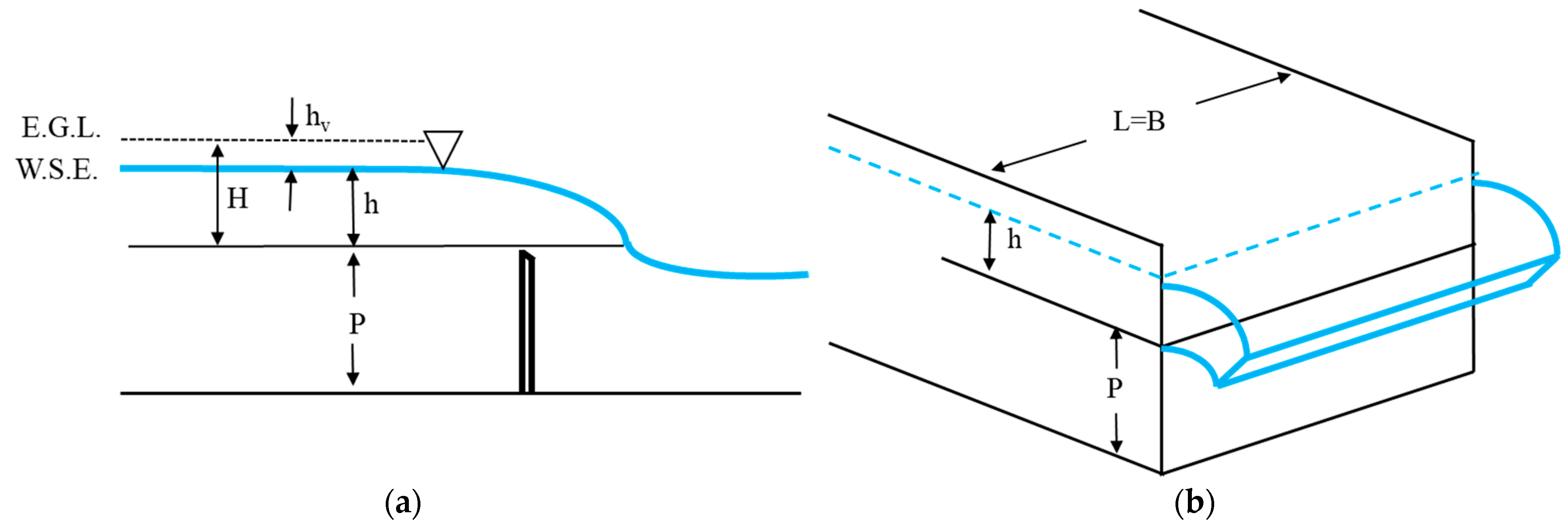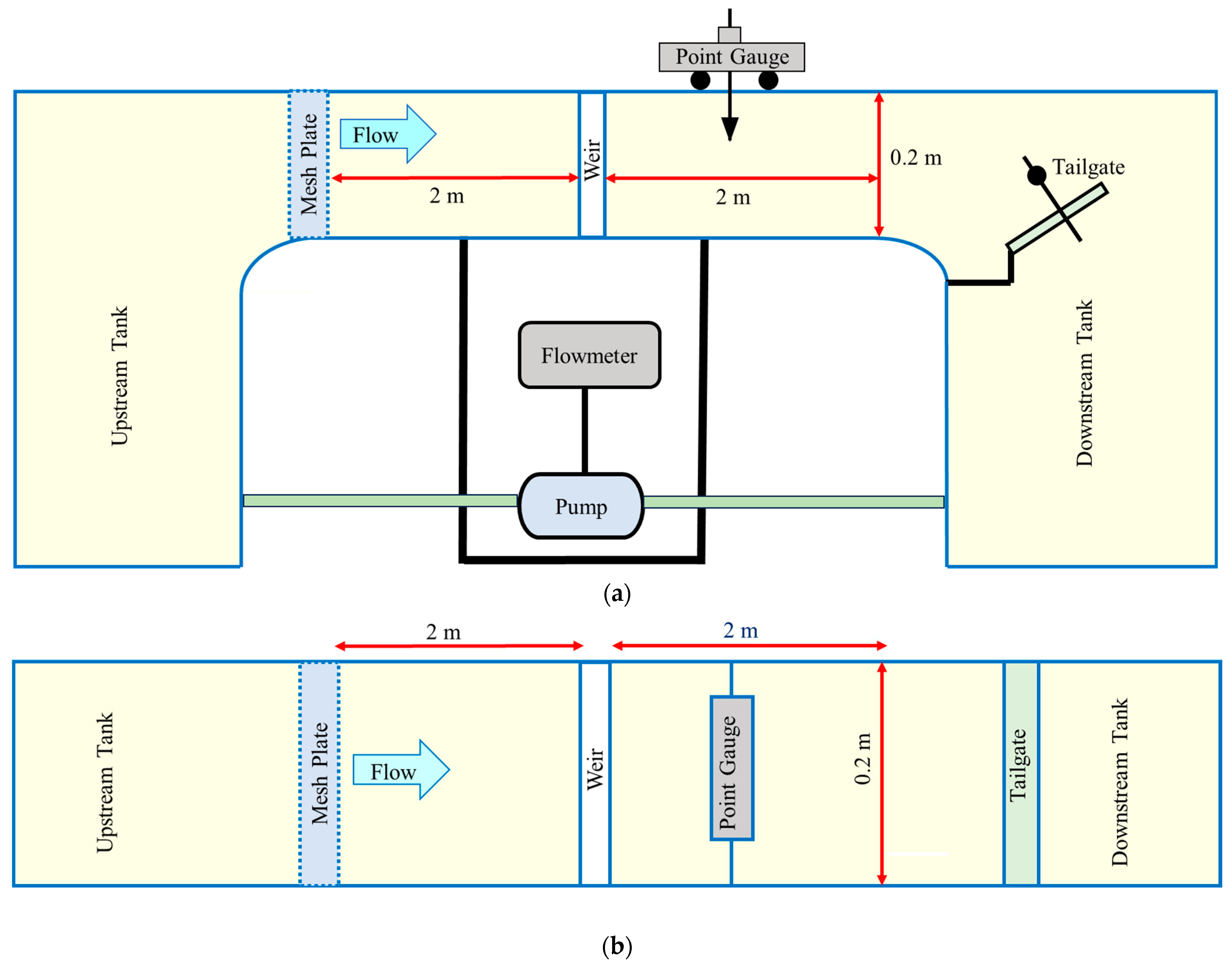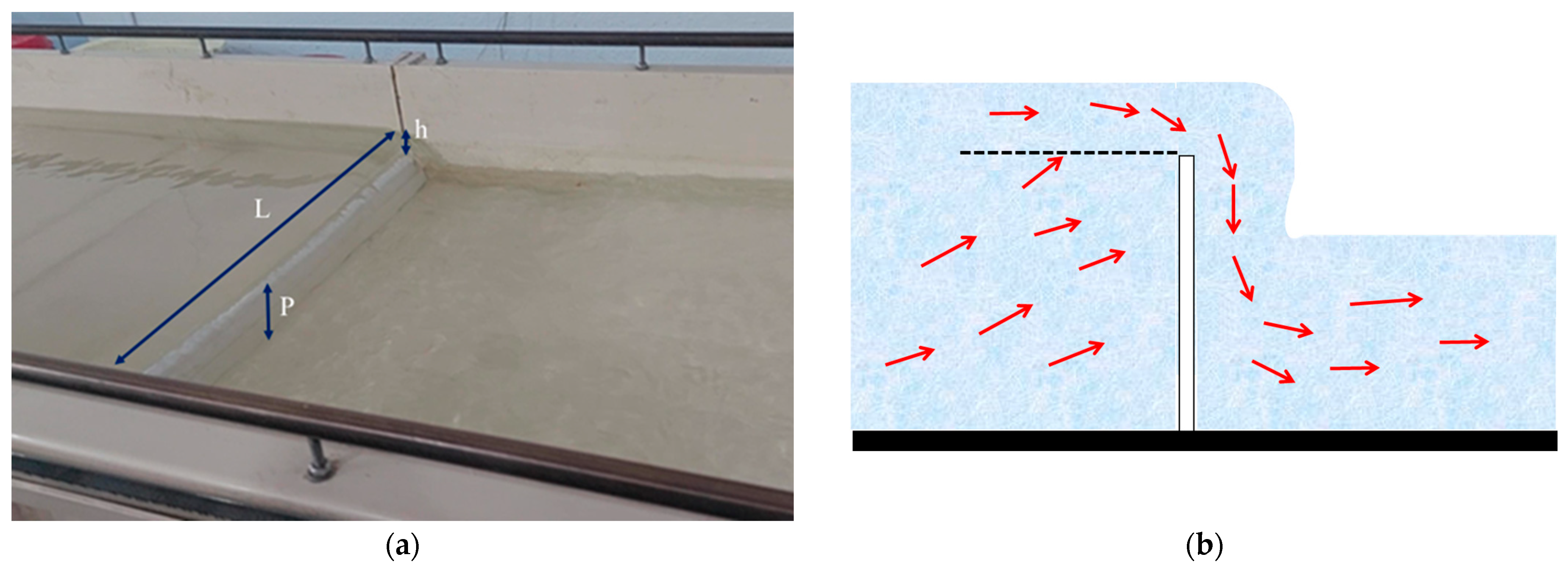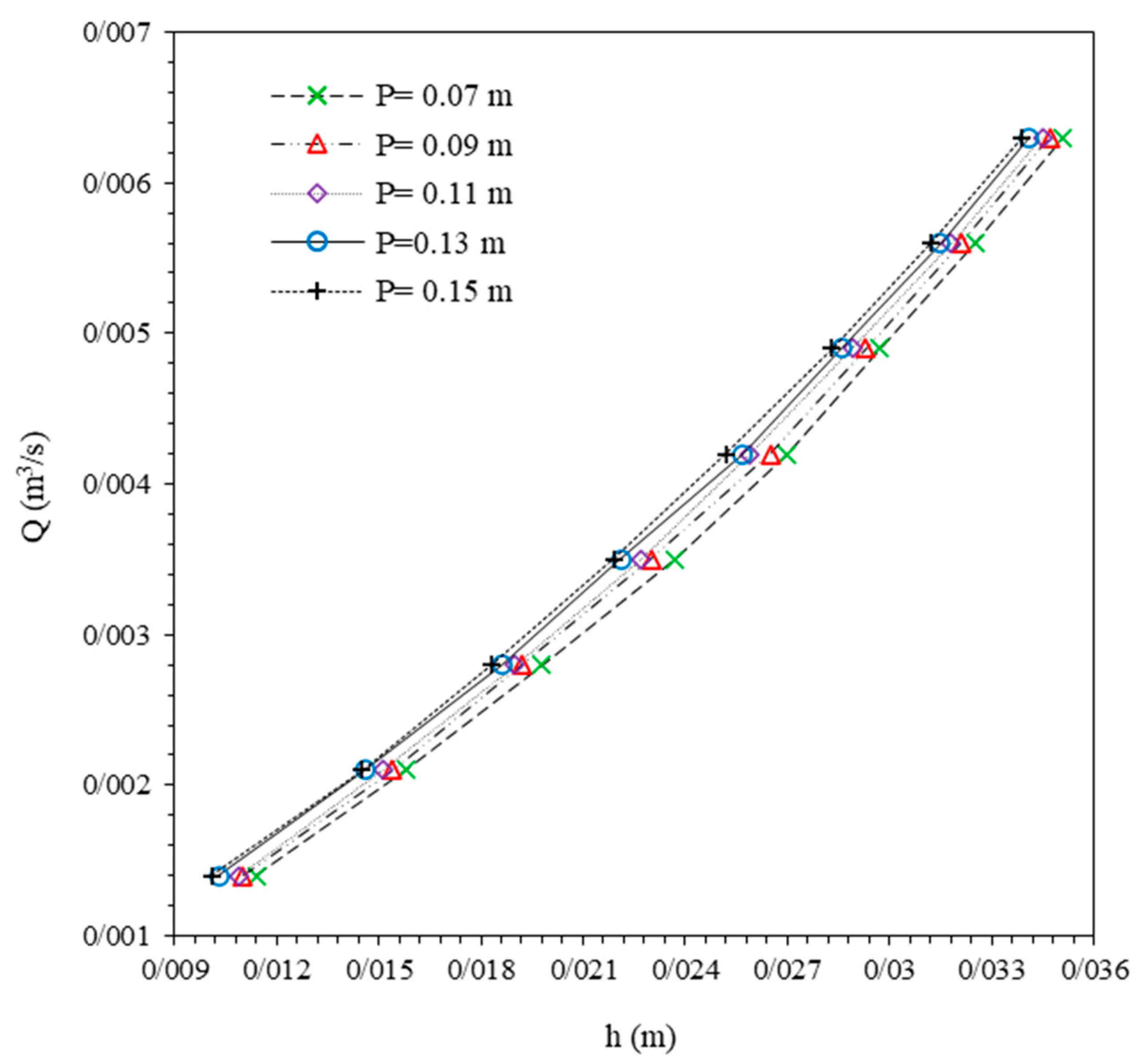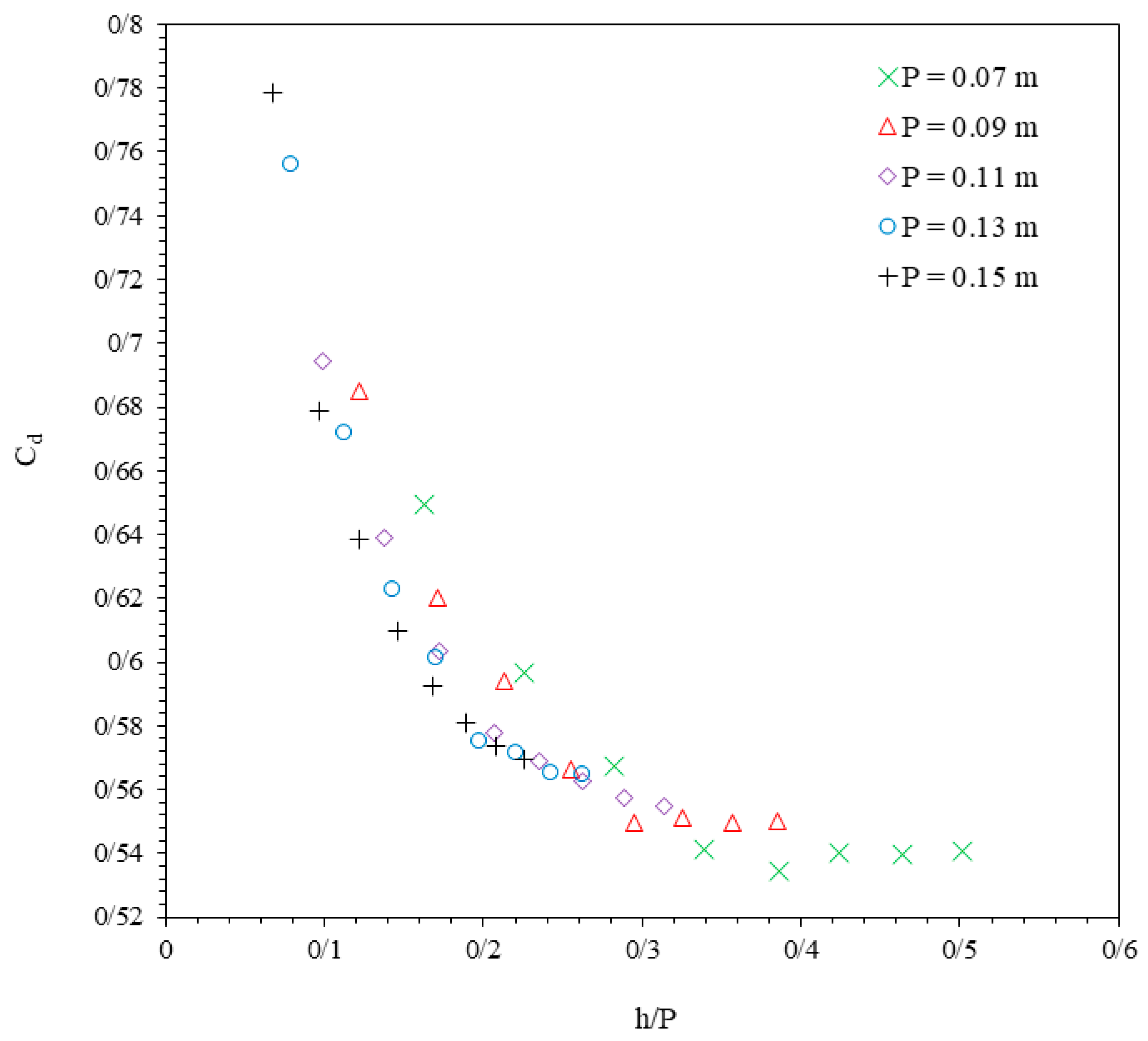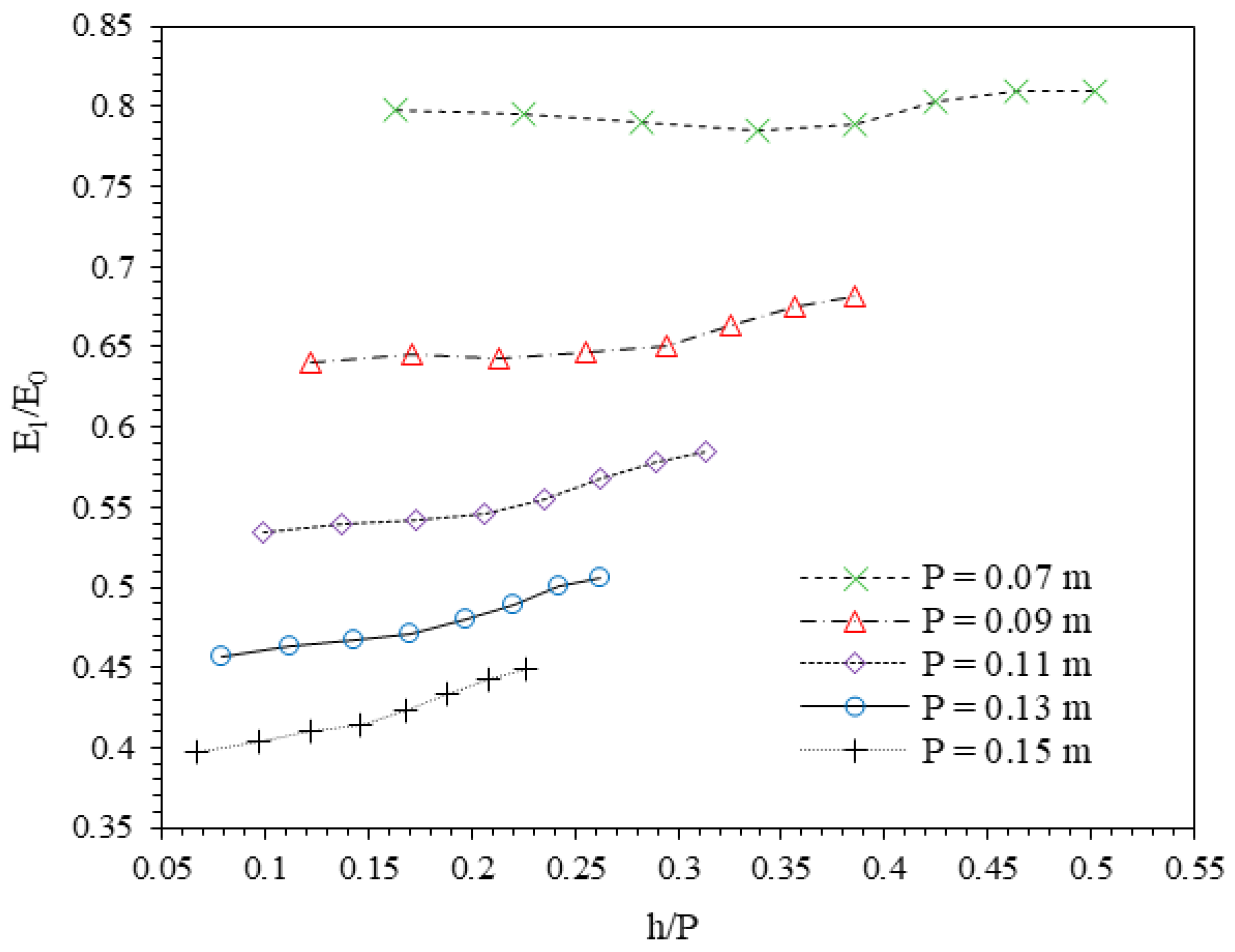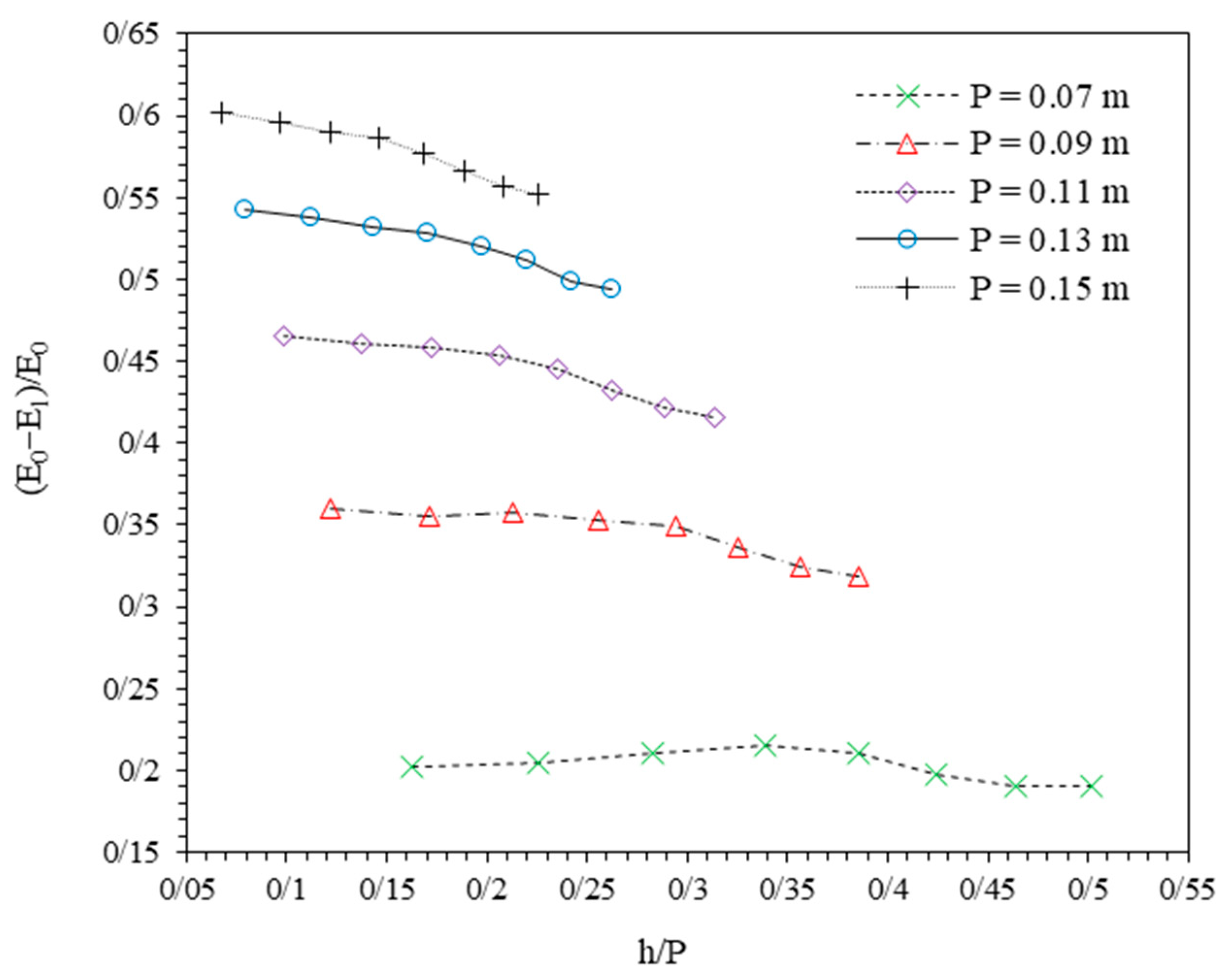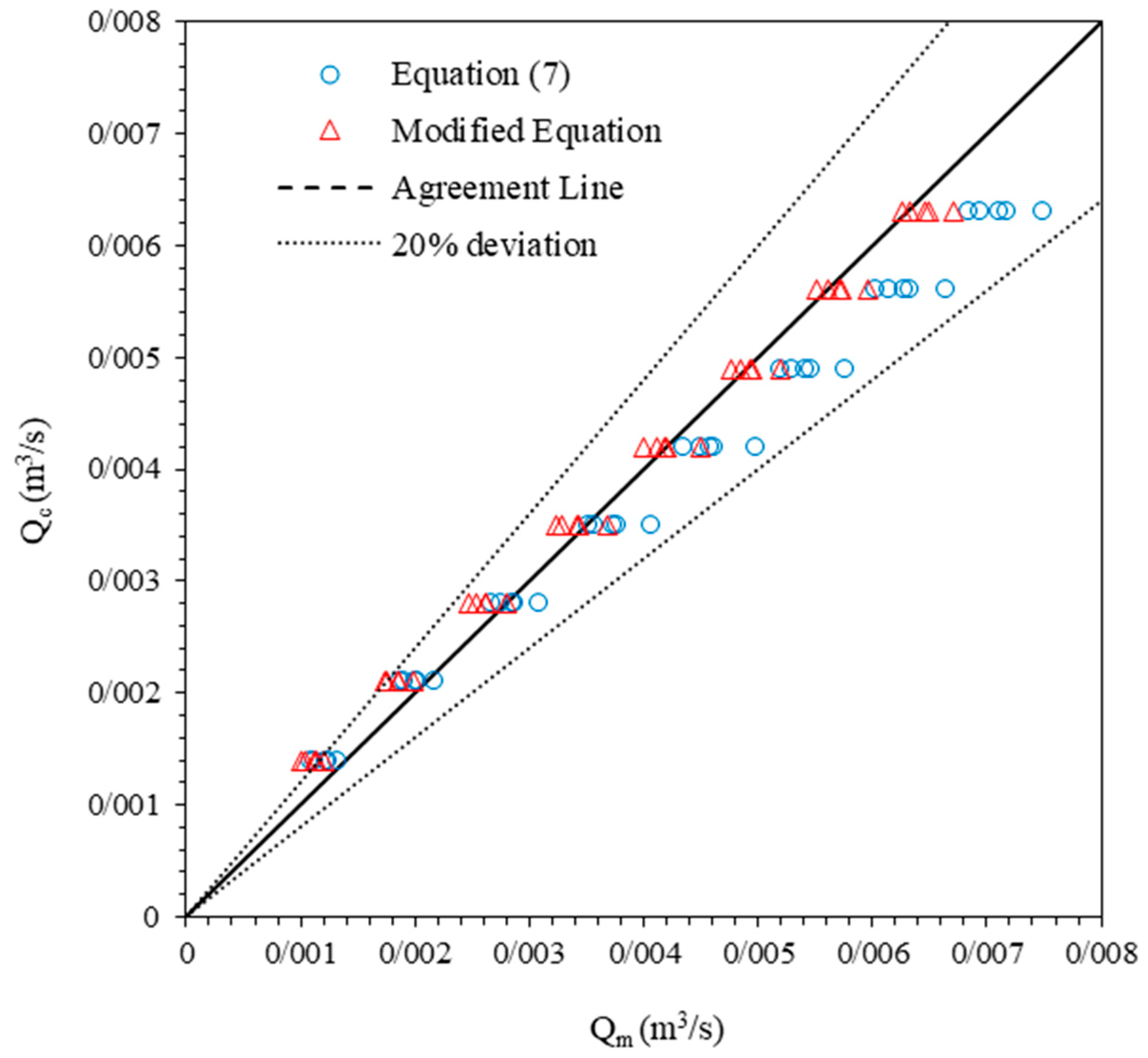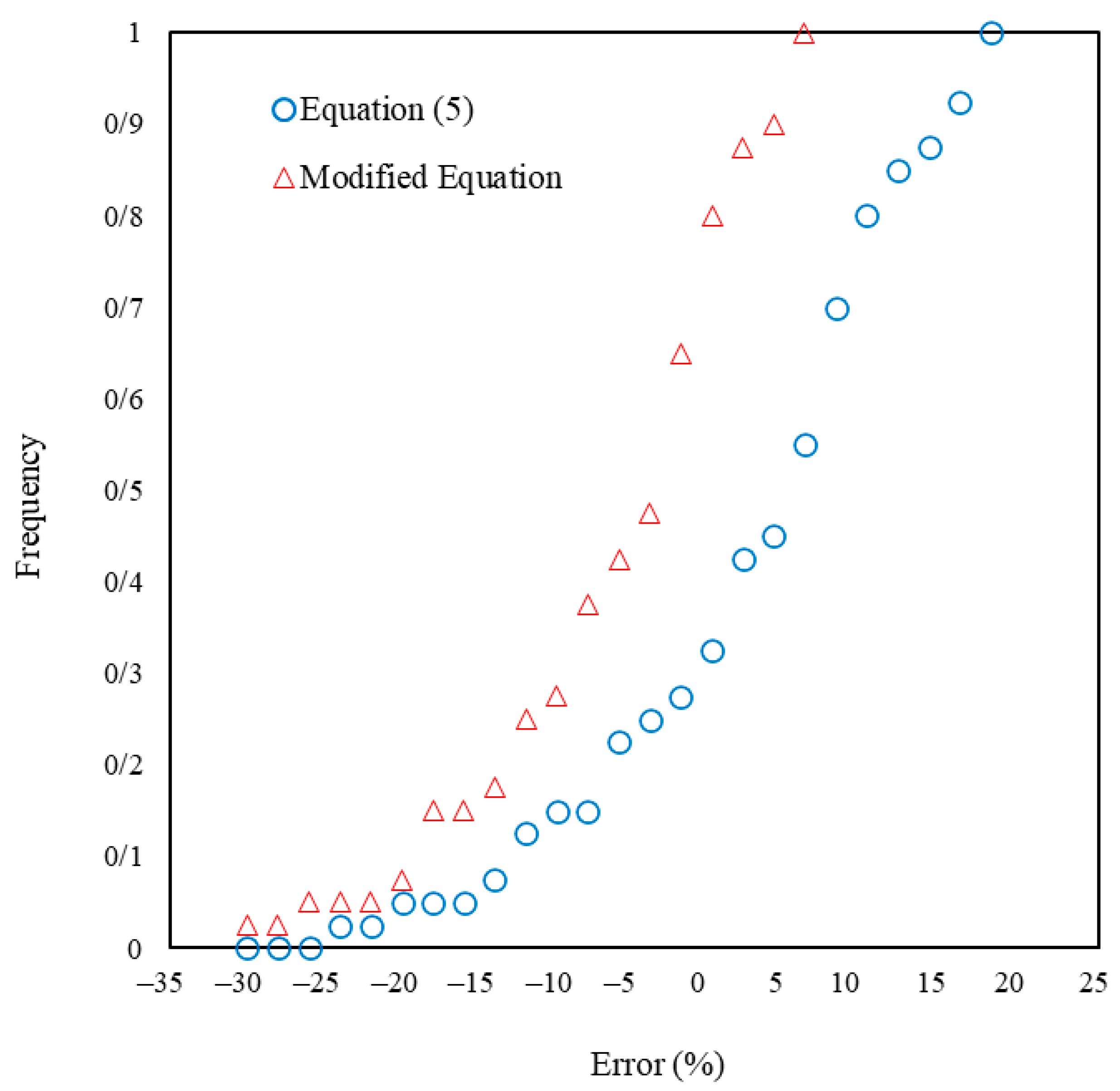1. Introduction
In recent decades, global warming and population growth have intensified climate change, influencing watersheds and water resources [
1,
2,
3,
4,
5,
6,
7]. This matter, along with the increasing water needs of human societies, increases the requirement for the correct water distribution for sustainable development [
8,
9,
10]. Additionally, inefficient irrigation and water distribution infrastructure due to the limited capacity of dams and maintenance requirements influence water resources management works [
11,
12]. Weirs could assist in reaching this aim through water level regulation and flood control in water distribution and conveyance networks in downstream regions [
13,
14]. Furthermore, weir safety in flood performance is of high importance [
15]. Weirs can be classified based on specific characteristics, including cross-sectional shape, plan view, or crest length. From the point of view of cross-sectional shape, rectangular, triangular, parabolic, elliptic, and circular weirs are common types [
16]. Investigating the discharge capacity of a weir crest length is an essential factor [
17,
18]. Hence, the importance of investigating weir design on the flow behavior over them, the flow discharge, and the flow characteristics downstream are apparent. Among weirs, full-width plate weirs (FWPW) are used in flow measurements and drainage purposes, as well as wastewater plants [
19,
20,
21]. These weirs are plate structures perpendicular to the flow direction, providing conditions for the water flow to pass through the whole width of the weir crest (
Figure 1).
The flow discharge passing through weirs can be calculated as follows [
22,
23,
24,
25,
26,
27]:
In Equation (1), Q is the discharge flow to the weir; L is the length of the weir, which equals channel width (B) in FWPW; h is the head on the weir; g is gravitational acceleration; and Cd is the discharge coefficient.
By increasing
Cd,
L, and
h, it is evident that discharge passing through the weir increases. When the plate is in an oblique condition (with an α angle compared with the flow direction),
L increases, and more flow passes through the weir with the same channel width (
B) and water head (
h) [
28,
29].
Investigating the flow behavior and measuring the flow discharge through the plate have been studied in several studies. Rajaratnam and Muralidhar [
30] examined the pressure and velocity field for flow over the crest of a plate weir with
h/
P = 0.2~8.5 to develop the theory for curvilinear in open channel flows.
The discharge coefficient of plate weirs can be defined as a function of the geometric ratios that describe the weir and the channel [
31]. The weir discharge coefficient depends on the ratio of the weir height (
P) to the head on the weir (
h). To measure the water head on the weir, a horizontal distance equal to 3 to 4 times
h should be assigned from the weir crest to neglect the influence of the curvature of the flow upon the water level [
32]. Sarginson [
33], by measuring low-level nappe profiles at low heads over plate weirs, provided an equation of the discharge coefficient. This equation considers the effect of surface tension on flow, and it has a lesser impact at
h > 0.05 m, but it is essential at low heads. It was observed that the effective coefficient values of weirs with different heights at very low
h/
P had 1.0 to 1.5% differences while generally varying less than 0.5% [
21]. Ramamurthy et al. [
34] proposed a formula between
Cd and
h/
P by investigating the flow over a plate weir at the end of a horizontal rectangular channel. Afzalimehr and Bagheri [
35], using the theory of complex variables, proposed an equation to estimate the
Cd of plate weirs with the theory of potential flow and showed that
Cd depends on a power equation of
h/
P. Arvanaghi and Oskuei [
36], using an experimental and numerical approach, investigated the effects of
h/
P, Froude number, and Reynolds number on
Cd of FWPW. They concluded that it tends to a constant value of 0.7. Experimental observations on a 20 mm thick round crested plate weir indicated that the rounded upstream corner can increase the discharge coefficient [
37]. At a constant discharge, changing bed slope has a negligible influence on
hb (brink depth or water head exactly on the weir crest), but it affects
h [
38].
However, these studies mainly focus on specific conditions, and the variations in discharge coefficients for wider ranges of weir heights and discharge rates remain less explored. Some studies, such as those by Afzalimehr and Bagheri [
35] and Arvanaghi and Oskuei [
36], have provided insights into the effects of geometric parameters, but comparative analyses across diverse weir height configurations and discharge scenarios have not been fully addressed. This gap highlights the need for more comprehensive investigations into the discharge coefficient variations across different operational conditions.
Experimental results on flow behavior and energy dissipation downstream of FWPW are lacking; only some studies are available for a rectangular contracted sharp-crested weir. It was reported by computing the energy loss for sharp-crested weirs that a hydraulic jump forms on the falling nappe at a low head that the main energy loss is attributed to a combination during the jump by increasing the tailwater depth [
39]. At the above phase of the impinging jet primary, energy dissipates in supercritical flow [
40]. Then, the high-velocity flow leads to considerable turbulence and energy loss as the flow converts to the subcritical state [
39]. In submerged flow, it is different, and the energy dissipation is minimal [
40]. This result occurs because the water flow stays constant and less turbulent, permitting better energy transport with decreased loss.
A review of previous studies indicates that some prediction equations were proposed for calculating the flow discharge (Q) and discharge coefficient (Cd) of the flow passing through the FWPW. Furthermore, (I) there is a lack of comprehensive analysis of the flow in FWPW, especially on downstream flow characteristics. (II) There are no findings on the energy dissipation in these types and prediction equations for calculating it in the literature. (III) There is a necessity to update the discharge coefficient equation of these weirs at low discharges, which are more sensitive to weir height variations. Therefore, the present study was conducted to fill the mentioned gaps. Since the ratio of h/P is the main effective parameter in discharge computations based on dimensional analysis, the present study investigated five varied weir heights (P = 7, 9, 11, 13, 15 cm) under eight different flow discharges. While investigating the flow behavior on the weir, the calculation of the discharge coefficient, the presentation of the modified equations, and the comparison with the available ones are also discussed. Also, the energy dissipation of the FWPW was investigated for the first time, and approximately accurate prediction equations were presented based on the experimental data. All the presented equations were validated with available equations and data, and the error values were given according to the frequency range. This study is novel, based on providing a new equation for the computation of the discharge coefficient of FWPW and the prediction of relative energy dissipation downstream of it.
The findings from this study aim to cover the gap in the topic literature by providing a comparative analysis of the discharge coefficients and energy dissipation downstream of FWPW via changing weir heights and discharge conditions. Due to the focus on the low-discharge range, where the weir’s performance is more sensitive, this study further contributes to the accuracy and application of the discharge coefficient and energy dissipation equations for the practical weir design of FWPWs.
5. Discussion
Full-width plate weirs (FWPW) are pivotal in accurately measuring flow in irrigation channels, wastewater treatment plants, and various hydraulic systems. Over the years, multiple studies have been conducted to evaluate the flow discharge passing through these weirs, investigate the flow profile, and compute the discharge coefficient. However, many of these studies have focused mainly on either flow discharge or energy dissipation behavior without providing a holistic knowledge of the weir’s behavior under various hydraulic conditions. This study provides a fundamental contribution to the understanding of full-width plate weirs with different heights (P = 7, 9, 11, 13, 15 cm), filling gaps in both experimental and theoretical frameworks. By advancing knowledge on energy dissipation and discharge behavior, this research offers practical tools for optimizing hydraulic system designs across various fields, ensuring sustainability and efficiency in water resource management. Furthermore, this work provides valuable insights into the performance of FWPWs across different flow conditions, emphasizing the influence of weir geometry, head-to-height ratio, and discharge on flow behavior. In particular, the study addresses gaps in the understanding of energy dissipation and discharge behavior, offering a more comprehensive view of FWPW performance under varied conditions.
Dimensional analysis and previous results have indicated that the ratio of the weir head to the weir height (h/P) is the most critical parameter affecting the results of hydraulic parameters in this weir. Given the complexity of flow behavior downstream of the weirs, including energy dissipation and flow separation, this study fills a critical gap by addressing these phenomena and updating the discharge and discharge coefficient results based on real-world experimental data. This approach directly links the findings to the research objectives, which include addressing the gaps in flow analysis, energy dissipation equations, and discharge coefficient modeling for low discharge conditions. The objectives of this study are to provide a comprehensive flow analysis, develop a prediction equation for energy dissipation, and update the discharge coefficient equation for low discharges, especially where the weir’s performance is more sensitive. To achieve this, five varied weir heights (P = 7, 9, 11, 13, 15 cm) under eight different flow discharges were investigated. This study focuses on the laboratory investigation of the FWPW with varying heights under different discharge conditions, offering insights into their performance across a broad range of practical scenarios.
The results indicate that additional investigation is needed in the field of FWPW and other types of plate weirs. The methodology and findings of the present study could be further developed in future studies focusing on flow behavior, downstream flow characteristics, and energy dissipation. For this purpose, an accurate CFD model could be applied to investigate a wider range of hydraulic conditions than those observed in this study, which were constrained by the limitations of the experimental model. Furthermore, based on the available findings and data, developing the results of the discharge coefficient and modifying existing equations through the collection of suitable datasets featuring varied configurations with high discharge and water head, using advanced techniques such as AI, can create robust research platforms.
The findings of this study extend beyond laboratory experiments, offering significant implications for real-world applications. In irrigation systems, insights into discharge behavior and energy dissipation can enhance water distribution efficiency, minimize losses, and ensure equitable channel flow. Similarly, in wastewater management, accurate discharge estimation and energy dissipation data can enhance flow control in treatment facilities, optimizing their operational performance. For flood control, understanding downstream energy dissipation enables better structural designs to manage high-flow events and mitigate erosion risks. Additionally, in hydropower systems, enhanced knowledge of flow behavior around FWPWs can increase the efficiency of small-scale hydropower projects, particularly in low-head conditions where precise flow management is crucial.
For future research, employing computational fluid dynamics (CFD) techniques is recommended to validate and expand these experimental results, enabling exploration of a broader range of hydraulic conditions and weir geometries. Machine learning techniques could be utilized to refine predictions of discharge coefficients and energy dissipation, leveraging large datasets to develop more robust models. Field studies are additionally essential for validating laboratory findings under diverse environmental and operational conditions, ensuring the applicability of findings in practical scenarios. Furthermore, detailed investigations into downstream flow dynamics, including flow patterns and turbulence, could optimize weir designs for specific applications, such as sediment transport management and ecological conservation. These efforts will enhance the functionality and reliability of FWPWs across various hydraulic systems.
6. Conclusions
The following findings were concluded in this research:
Discharge (Q) and head over the weir (h) exhibit a linear relationship consistent with the results reported in the previous studies. Furthermore, for a constant discharge, increasing the weir height slightly reduces the weir head. This linear behavior enhances the predictability of flow rates, making FWPWs reliable for applications in irrigation systems and wastewater management, where accurate and consistent flow measurement is essential.
A modified equation was suggested only based on variations of parameter h/P for calculating discharge, which reduces RMSE from 0.0005 to 0.0002, MAE from 0.0004 to 0.0002, and increases R2 from 0.996 to 0.997. This equation is valid for the range 0.08 < h/P < 0.53. Also, results of the frequency distribution of the errors for computed flow discharge (Qm) for the modified equation with experimental data present acceptable accuracy of the suggested equation. The statistical results confirm that the proposed equation is more suitable for engineering purposes. The reduced error metrics support its applicability for engineering purposes, particularly in designing systems that require precise discharge estimation. This improved accuracy ensures better flow regulation, minimizes wastage, and optimizes resource allocation in hydraulic projects.
Laboratory models’ results indicate that the discharge coefficient of the FWPW decreases as
h/
P increases. The average
Cd values for
P = 0.07, 0.09, 0.11, 0.13, and 0.15 m were obtained: 0.5763, 0.5833, 0.5947, 0.6161, and 0.6277, respectively. The lowest and highest
Cd values were 0.5343 (test A
5) and 0.7785 (test F
1), respectively. The comparison between the present data and results adapted from Arvanaghi and Oskuei [
36] confirms the compatible trend of the
Cd results with power. Notably,
Cd values in Arvanaghi and Oskuei [
36] are greater than in the present study. This difference in
Cd results can result from differences in the parameter range in the experimental model and channel geometry. The channel width in Arvanaghi and Oskuei [
36] is about 42% of the present model, and
h and
h/
P values are much larger than those in this study. Consequently,
Cd values in both datasets decrease as
h/
P increases; through in Arvanaghi and Oskuei [
36], they reach 0.7, whereas the present study recorded 0.54. These results offer valuable insights for designing tailored FWPWs that meet specific site conditions and operational requirements. The findings emphasize the importance of accounting for geometric variations and hydraulic conditions when adapting designs for field applications.
Average values of relative residual energy (E1/E0) for P = 0.07, 0.11, 0.13, and 0.15 m were 0.7973, 0.6558, 0.5559, 0.4792, and 0.4217, respectively. Also, average values of relative energy dissipation ((E0 − E1)/E0) were 0.2027, 0.3442, 0.4441, 0.5208, 0.5783 for P = 0.07, 0.11, 0.13, 0.15 m, respectively. At a constant discharge, E1/E0 decreases by increasing weir height, and in a constant P, increasing flow discharge increases E1/E0 slightly. It concluded that at a constant q, (E0 − E1)/E0 increases as weir height increases, and at a constant P, flows with higher discharges result in slightly lower relative energy dissipation. These results demonstrate that increasing weir height enhances energy dissipation, which is critical for mitigating downstream erosion and maintaining structural integrity. Practical applications include optimizing energy dissipation in irrigation channels to prevent soil erosion and downstream sedimentation. These findings can also guide the design of weirs in hydropower and flood control systems, where efficient energy management is essential.
This research investigated the hydraulic model of a full-width plate weirs in a laboratory and like other experimental studies, is subject to limitations and uncertainties. However, efforts have been made to minimize their effects on the results through the approximate application of suitable model design and implementation. One limitation is the measurement Process, which, as mentioned in the experimental setup section, incorporates water depth and discharge measurement criteria consistent with those of previous studies. Another is the limited range of parameters due to the low height of the channel and its small scale, which could have affected the weir height. Nevertheless, the weir height remains within a reasonable range compared with other studies [
36], as presented in
Table 7.
